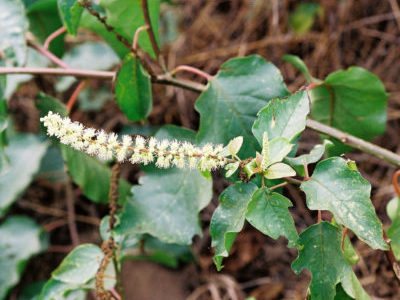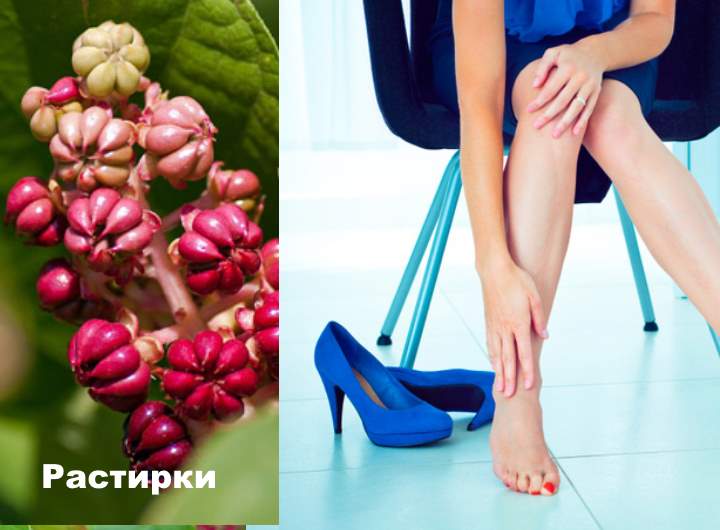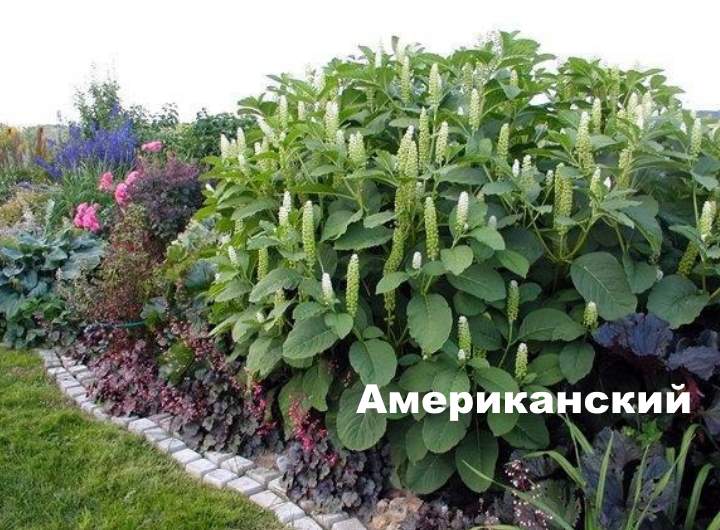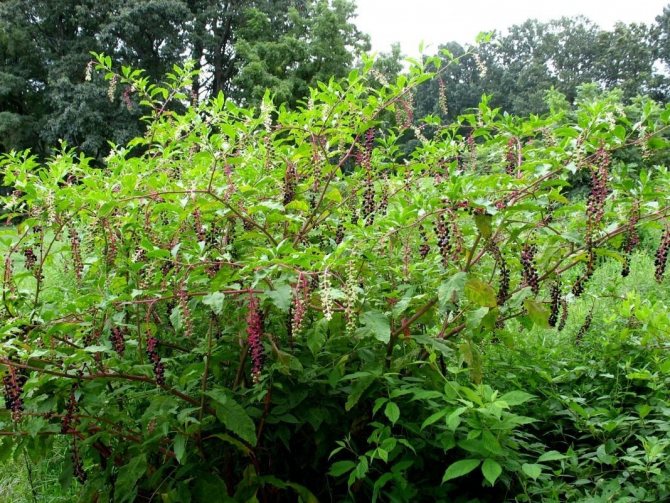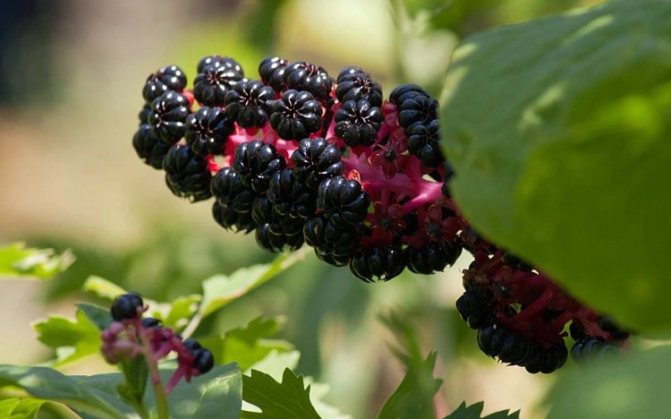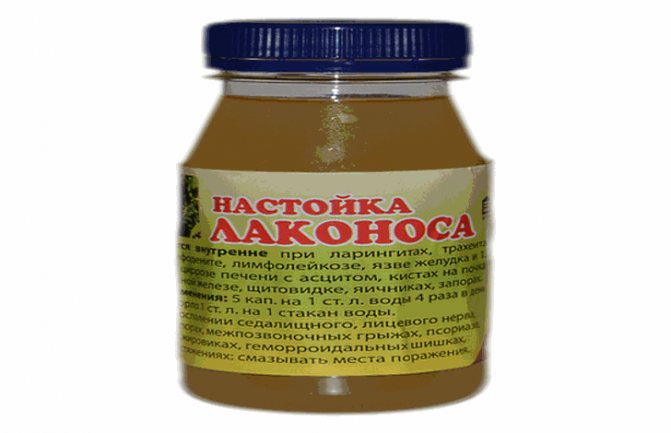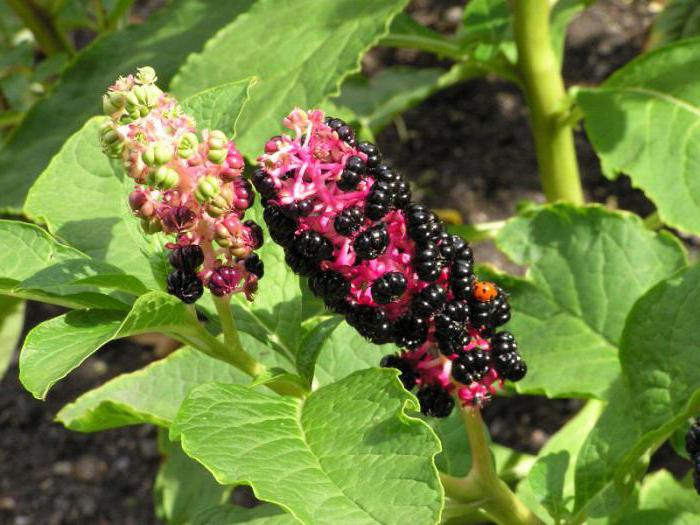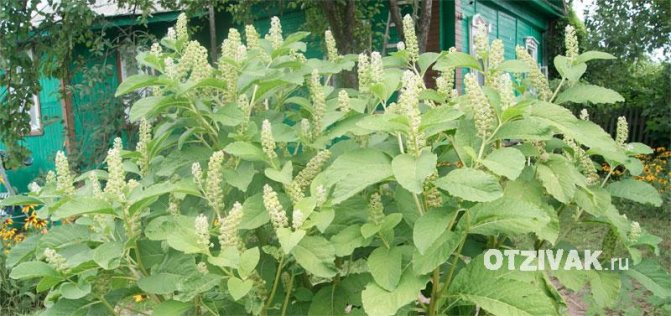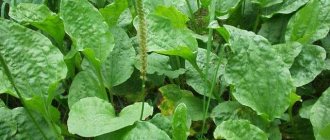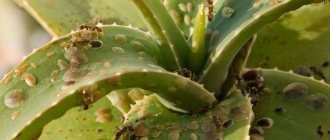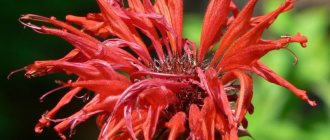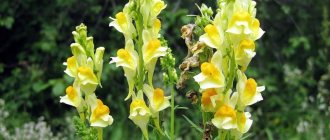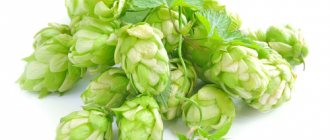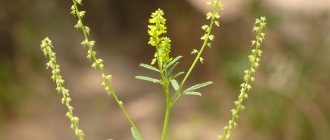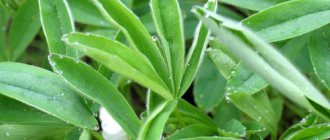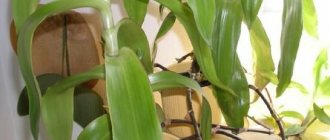The article will tell you about a plant with an unusual name - lakonos. In the material you will find a photo of the plant, learn about where it grows and what medicinal properties it has.
Lakonos (American phytolacca) - a plant that is truly gigantic in size. On average, phytolacca can grow up to three meters in height. The stems of the lakonos are thick and branching, the leaves are elliptical, the flowers are small, gathered in beautiful tassels, and the fruits are dark purple in color. The plant is unusually beautiful, you can make sure that by looking at a magnificent photo of a phytolacca in full growth, but you should know – Lakonos is poisonous and should be used with extreme caution for medicinal purposes.
Lakonos plant: medicinal properties
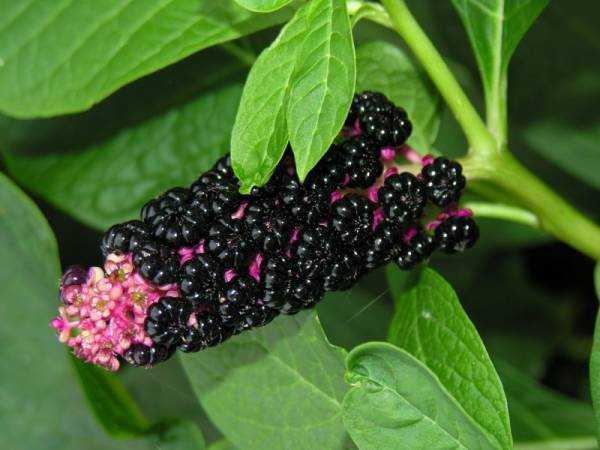
The benefits of phytolacca are due to the chemical composition of the plant. Lakonos roots are especially rich in useful elements. Essential oils, flavonoids, a group of saponins, formic acid - this is an incomplete list of trace elements that contribute to the fight against diseases. In the stem and leaves of the plant there is a large supply of ascorbic acid, and in the berries - alkaloids, vitamins PP and thiamine.
Thanks to such a rich composition, the medicinal properties of the lakonos are determined:
- reduces inflammation;
- heals wounds;
- relieves pain;
- fights germs;
- has a laxative effect;
- strengthens the immune system;
- reduces the negative effects of alcohol and nicotine;
- removes worms from the body;
- activates the brain;
- normalizes metabolic processes;
- stimulates the outflow of urine;
- removes mucus from the respiratory tract;
- has an antirheumatic effect.
Application in therapy allows you to cure or reduce the manifestation of such diseases:
- anemia;
- arterial hypertension;
- pyelonephritis;
- urolithiasis disease;
- hemorrhoids;
- skin diseases;
- pathology of the cardiovascular system;
- radiculitis;
- frequent headaches;
- osteochondrosis;
- swelling of the joints;
- climacteric syndrome;
- arthritis;
- visual impairment;
- obesity;
- decreased functionality of the thyroid gland;
- joint pain.
The results of modern medical research make it possible to consider lakonos as a means to combat leukemia and AIDS. A unique protein (PAP-toxin) was found in the plant, which blocks the active processes of pathological cells.
In America, many European countries, the fruits and root of phytolacca are in the register of medicines.
Plant characteristics
American Lakonos was brought to European countries from North America, or rather, from Bermuda. It is actively cultivated in botanical gardens, flower gardens, and often becomes a wild plant. He loves dense soils on the outskirts of roads, grows among weeds, cultivated plants in gardens, vegetable gardens, near dwellings, as well as among shrub thickets. It is considered a common plant on the territory of the Crimea peninsula, in the East and North of the Caucasus Mountains.
Morphological signs
Lakonos American belongs to the list of the largest herbaceous perennials, reaching a height of 3 m.
- Roots. The depth of penetration into the soil is about half a meter. The fleshy central root can grow strongly, forming a multi-headed rhizome, the weight of which in adult plants reaches 10 kg.
- Stems.Often there are several of them from the root. Each thick stem has a cylindrical shape and is particularly juicy. Color - from green to greenish red.
- Leaves. Placed on opposite stems. Attached with short angular petioles. The base is narrowed in the form of a wedge, the edges are solid. Often the leaf blade is ovoid or ovoid-elliptical in shape. They have a pointed edge.
- Flowers. Small in size, form compacted paniculate inflorescences. Fastened with short flower-noses, the length of which does not exceed one and a half centimeters. The perianth is simple, white or green, reddening over time. The lakonos is characterized by long flowering from June to August.
- Fruit. Unripe fruits are dark red and have a ribbed surface. When ripe, they acquire an almost black color, a rounded shape, the ribbing becomes less pronounced, the surface shines. Inside are black, hook-shaped seeds that are flattened at the sides. Fruiting of the plant is observed in late August and early September.
Inflorescences are of great decorative value, since even cut, retain their original appearance for up to two weeks. Fruits also have decorative properties, decorating garden plots until October in good weather conditions.
Procurement process
Roots are considered the main raw material of the lakonos, which has a therapeutic value. Their preparation requires care and protective measures in order to avoid irritation of the skin surface, as well as mucous membranes.
- Collection. It begins in the autumn after the complete cessation of the growing season of the lakonos. The plant is dug up with a shovel, the aerial part is chopped off.
- Processing of raw materials. The roots of the lakonos are washed with a large amount of running water, the spoiled ones are selected, cut into pieces. Important: it is absolutely impossible to harvest roots with red pulp. The normal state of the lakonos raw material is a light yellow or beige core color.
- Drying. Lakonos rhizomes are laid out under a canopy or in a dryer in one layer. The use of mesh pallets is desirable. The temperature for the dryer is about 50 ° C.
Dried rhizomes should be packed in cotton bags and stored in a dark place with good ventilation. Leaves and fruits of the lakonos are also prepared. Leaves are harvested throughout the growing season and dried in the shade. The berries are dried using dryers or ovens at a temperature of 90 ° C.
Valuable composition
Lakonos American differs from other medicinal plants in a large concentration of potent substances with special specificity. The most concentrated part of the plant is the root system. She is rich:
- alkaloids (phytolaccin);
- lectins;
- sugars (sucrose and starch);
- essential oil;
- triterpenoids (oleic and jaligonic acids);
- steroids (spimasterol, stigmastenol);
- phytaloccosides;
- bitterness;
- organic acids (phytolaccic and formic).
American Lakonos is considered an anti-cancer plant because its rhizomes contain a special protein compound, PAP-toxin. It is able to interrupt the pathogenesis of some types of leukemia, and is active against atypical cells. The leaves contain high concentrations of:
- saponins;
- flavonoids (quercetin, kaempferol, astragalin);
- ascorbic acid;
- tannins.
Also, the chemical composition of the leaves includes the following phenolic acids:
- vanilla;
- hydroxybenzoic;
- synaptic;
- kumarovaya;
- ferulic;
- coffee shop.
The fruits of the lakonos and its seeds contain a large amount of:
- alkaloids;
- sugary substances;
- saponins;
- anthocyanins;
- triterpenoids;
- neolignans (isoamericol);
- organic acids;
- pectins;
- B vitamins;
- vitamin PP;
- potassium.
All parts of the plant are considered poisonous due to the content of toxic alkaloids, therefore, their use for medicinal purposes requires special care.
Benefits of stems, leaves, berries and root
Different parts of the lakonos have a special effect on the body due to their specific composition.


Most often it is applied to the roots.
Preparations based on them are used:
- to get rid of ringworm, skin rashes, hemorrhoids;
- against rheumatism, bruises;
- to remove bruises on the skin, relieve itching;
- against throat diseases (tonsillitis, laryngitis, pharyngitis, tonsillitis);
- to fight the flu, to strengthen the immune system;
- to cleanse the blood;
- to relieve joint pain.
Where and how it grows
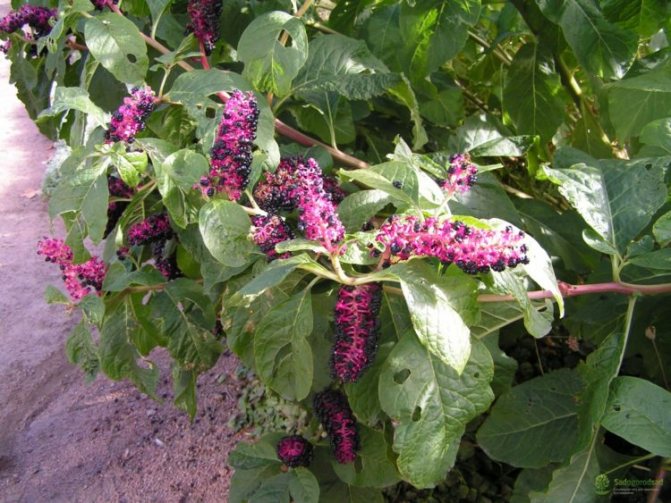

Lakonos are quite unpretentious, so they easily take root in any conditions. However, in order for the plant to retain its beautiful decorative appearance, it needs care. In neutral soils, the plant will thrive. Loam is great.
Phytolaccs love light, but they will also develop well in the shade, only flowering and fruiting will proceed somewhat later. Flowering occurs from June to September, fruits appear in August.
Traditional medicine recipes
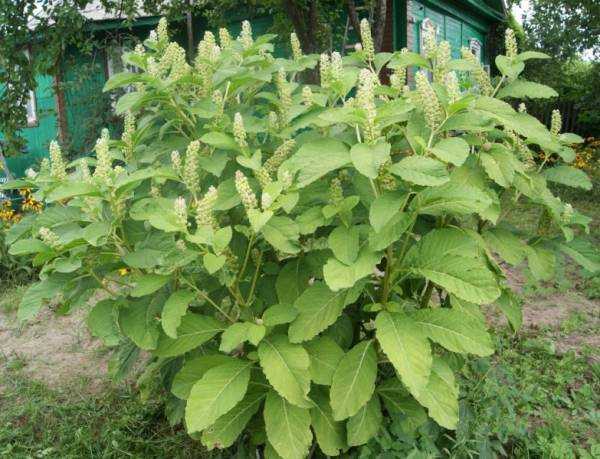

Healers use the plant for therapy for various pathologies. Properly prepared remedies relieve unpleasant symptoms and improve the general condition of a person.
Fitolakkoy garden design options
We can say that the popularity of an exotic perennial is only gaining momentum. Many gardeners have never encountered such a culture and do not know how it can be used to beautifully design a site.
The easiest and best option is to plant a lakonos on an empty area of the garden, which is not planned to be planted with vegetable and flower crops. This way you can revitalize your garden area.
A tall and spreading plant can be planted as a hedge or to divide the area into zones (for example, recreation areas).
A bush in the background of a flower garden and undersized shrubs will look beautiful.


Tincture for otitis media, laryngitis and sore throat
Inflammatory diseases of the throat are effectively eliminated with phytolacca tincture.


For cooking, you need 2 tbsp. tablespoons of dry raw materials from crushed roots and half a glass of 70 percent alcohol. The dosage can be increased, while maintaining the proportion (1:10). The product is infused in a sealed container for 18-20 days.
For oral administration, use 10 drops of tincture 2-3 times a day. To gargle, you should 1 tbsp. dilute a spoonful of the product in 200 grams of water.
Other areas of application
Lakonos American is actively used not only for medicinal, but also for economic purposes.
- Like a honey plant. According to reviews, the plant serves as an excellent object for collecting nectar by bees and producing fragrant honey.
- Like a dye. Use juice, a decoction of the fruit - for touching up silk or woolen fabrics. Fruits and juice are added to the preservation to give the products a specific shade. Also, with the help of lakonos juice, light types of young wines are tinted.
- Like a spice. The fruits of the lakonos are put in pickles for cucumbers, peppers, and garlic. Thanks to this, pickled vegetables acquire a special astringency and light pungency of taste.
- As decoration. A flowering and fruiting plant is harvested to create bouquet arrangements or dried for interior decoration.
Young shoots of the plant in cooking act as a substitute for asparagus. After boiling with a little salt, they are eaten to improve digestion, but in very small quantities, since such a dish can provoke diarrhea.
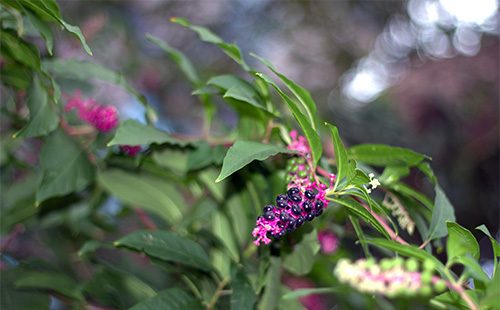

Infusion for the treatment of joints
To relieve the painful sensations of rheumatism or arthritis, an aqueous infusion of lakonos is used.


For him you need to take 2 tbsp. tablespoons of dry leaves of a plant, pour boiling water and place in a closed vessel.The product should be infused in a dark cool place for at least 14 days. This time is enough for useful substances to be released.
With a ready-made infusion, rub problem areas of the back, joints. For compresses, you need to soak a cotton handkerchief or other cloth in the solution and put it on the problem area for half an hour.
Healers also recommend using this method in case of fever. To do this, put a compress on the forehead.
How to grow, care, pests, diseases
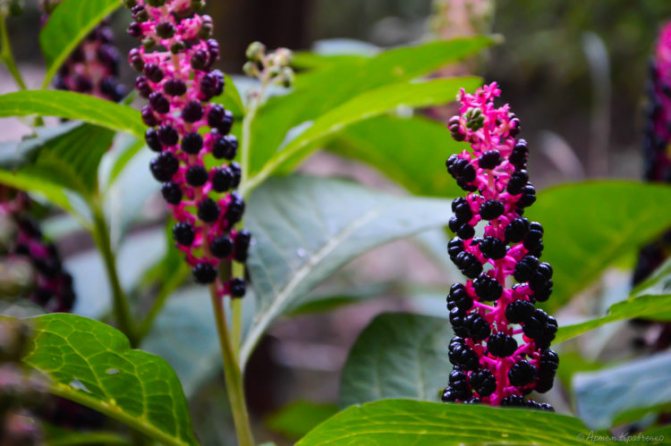

- There is an opinion that lakonosy grow like weeds, requiring no maintenance. This is partially true, the plant will not die without care, but it will lose its attractive appearance. Therefore, when growing it, you should take care of regular watering (especially the American phytolacca variety needs it).
- After the arrival of frost, it is recommended to cut the ground part to the base. And to preserve the basal buds, it is recommended to mulch the phytolacca - cover it with a layer of dry leaves or other types of mulch 10 centimeters thick.
- The plant is considered one of the most resistant, it is practically not susceptible to diseases and pest attacks. Moreover, phytolacca repels pests, especially effectively - sawflies, moths and other uninvited guests of the gardens.
- Lakonos spreads well by self-seeding. However, if desired, it can be propagated by seeds or by dividing the rhizome.
- Seed propagation is carried out without cleaning the pulp of the berries, deepening the berries to a shallow depth of the beds. Seeds quickly lose their germination, so they are sown immediately after harvest. In the spring, early shoots appear, which already in the first year give abundant greenery and the first inflorescences.
- It is possible to divide the phytolacca rhizome for vegetative propagation only in young plants, since the roots of adult specimens sit quite deeply, and it is no longer possible to get them without damaging them.
- It is best to plant phytolacca in partial shade, in a cool place without drafts, in light, drained soil.
Decoction for dental diseases
With toothache and stomatitis, decoctions from the plant will help.


The first recipe is from berries. It is necessary to pour a glass of water into 1 tbsp. spoon phytolacca and cook for 5 minutes. The broth should be infused for half an hour, after which it is ready for use.
For a decoction of the stems and leaves of the lakonos, you need to take 2 tbsp. tablespoons of dry crushed raw materials. In a glass of boiled water, dilute a pinch of salt, pour phytolacca with this solution. Cook for 5 minutes, cool. You can rinse your mouth with this broth 5-7 times a day.
Pest and disease control
Phytolacca is rightly considered one of the most resistant garden perennials. Pests and diseases on the plant are extremely rare, but phytolacca repels pests from neighboring plants (it is especially effective against pests of the orchard - sawflies, moths, etc.).
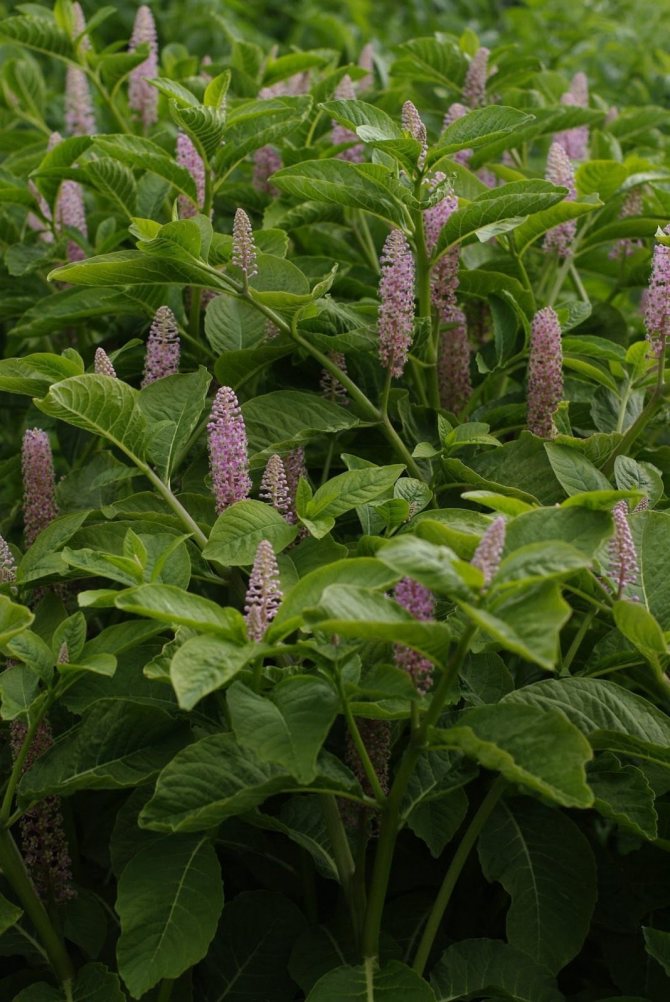

Lakonos mnogotachinovy, or Lakonos claviferous (Phytolacca polyandra).
Useful properties of juice, ointment, oil
Lakonos juice helps to relieve skin inflammations of various kinds, ulcers and edema, for the treatment of hemorrhoids. To do this, strain the berries crushed to a liquid state through cheesecloth.
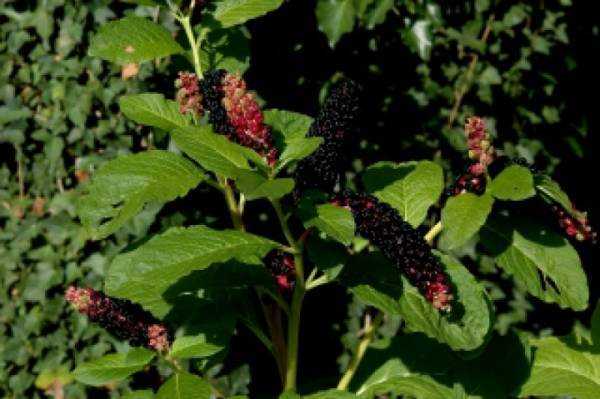

The sap of the plant is part of the complex therapy for rheumatism and radiculitis. It should be consumed every day, 50-60 mg for 3 months, without interruption. Phytolacca stimulates the immune system, promotes recovery.
Plucked leaves of the plant relieve symptoms of skin diseases (scaly lichen, fungal growths). They must be applied to the site of inflammation or growth.
For these purposes, an ointment from chopped roots is also used. They must be brought to a powdery state and combined with fat (butter, lanolin, pork fat) in a ratio of 1:10.
Oil from phytolacca is prepared in a similar way, but instead of fat, vegetable oil (flaxseed or olive) must be added to the powder from the roots. The drug is suitable for getting rid of tumors and growths.
To improve the work of the stomach, traditional medicine recommends eating 2-3 dried berries of the lakonos twice a day.
Reproduction
Seeds
Lakonos can grow from seeds. They are sown immediately after harvest, since the germination of seeds is quickly lost.
The berries are not peeled from the pulp and are planted without deeply deepening.
In the spring, the seeds sprout quickly as soon as the soil warms up. Development is fast and some shoots will bloom in the same year.
The transplant is done in April next year after the shoots appear. The full size of the plant is achieved only after two years.
If the berries are left on the bushes, then self-seeding occurs. Young seedlings can also be used for transplanting.
Separating roots
Dig up the roots carefully, trying to inflict as little damage as possible. After dividing the roots, plant them in the prepared holes.
!!! Important: dig holes in large sizes
Water the roots abundantly. In adult plants, the roots go deep into the ground and grow up to 10 kg in weight. For division, you need to take young plants.
In just a month, Lakonos can reach one meter in height. Therefore, the shoots must be planted as soon as they become more than 10 centimeters, at a distance of at least 60 centimeters.
Lakonos - application in homeopathy
Official medicine has also appreciated the beneficial properties of the plant. American homeopaths were the first to use it. Doctors use an extract from the lakonos to treat cancer, disorders of the musculoskeletal system, to normalize the lymphatic system, and strengthen immunity.
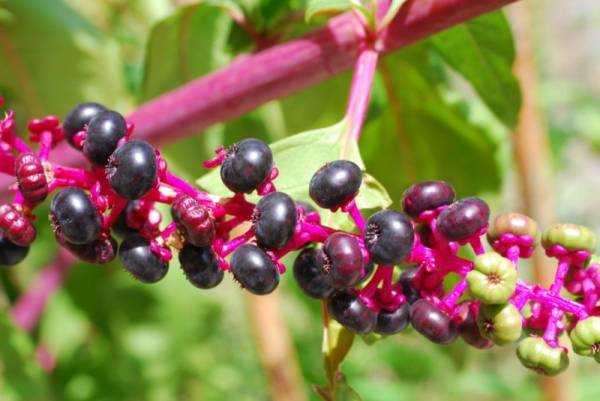

Lakonos roots are part of the homeopathic medicines Anginol, Tonsipret, Merifit, which are used to treat the throat. Tincture from the plant's fresh berries is used in Phytolacca decandra, which has a wide range of uses.
Medicinal properties of phytolacca
Phytolacca, despite all its toxicity, is a useful plant and has a number of medicinal properties. Herbalists and healers use phytolacca to treat migraines, high blood pressure, kidney pathologies and radiculitis pain.
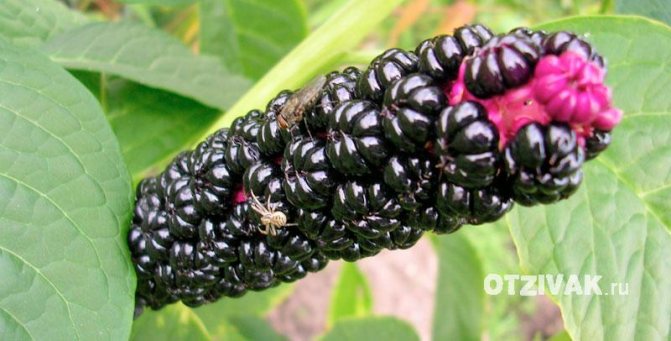

Lakonos American is also valued for its excellent diuretic properties and the ability to destroy various types of helminths and parasites in the body. Taking medicine from the laconos can have a laxative and expectorant effect. Due to the listed qualities, phytolacca is widely used in modern homeopathy.
Decoctions are prepared from the leaves of the plant, which are consumed internally, but also this part of the phytolacca can be used to make compresses and lotions for boils, irritation of the skin, therapy of hemorrhoidal cones. Tincture of leaves on alcohol will help eliminate excruciating pain in arthritis or sciatica.


If you are going to use phytolacca and the means from it for the treatment of any ailment, be sure to get detailed advice from a doctor. The use of medicines from the lakonos in the wrong dosage is fraught with severe poisoning.
Contraindications and possible harm
Due to its special toxic composition, the American lakonos has a number of contraindications. They must be taken into account in order to avoid undesirable consequences.
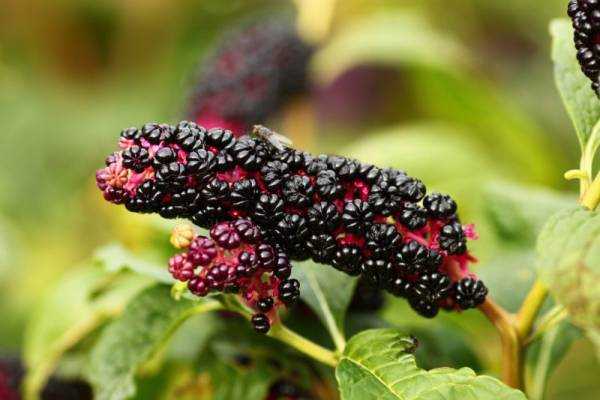

Who should not use phytolacca-based preparations?
- Teenagers under 18. The body is not yet ready for the use of toxic substances of this concentration.
- For women during pregnancy. The sap of the plant increases the tone of the uterus, which threatens a miscarriage.
- Nursing mothers. There is a high probability that toxins will enter the baby's body along with milk.
- Allergy sufferers.If you apply the drug to the skin, irritation and rash may appear. To find out if there is an allergic reaction to lakonos, you must first test the inner bend of the elbow.
The plant can be consumed only after consulting a doctor. The poisonous composition of phytolacca requires adherence to a strict dosage in order to protect the body from poisoning.
Increasing the dose causes severe complications.
Types and varieties of American lakonos, appearance
The plant, known in other countries as American phytolacca, is often called lakonos, kermes berries, Jewish ivy, or fat grass. American Lakonos is a herbaceous perennial belonging to the Lakonosovye family. The genus of the same name includes about 25 different species (they grow like a shrub, grass), on our continent the most common American Lakonos and Berry Lakonos.


- The type of berry laconos (drupe, grape) is a perennial herb up to 1.5 m high, outwardly similar to its poisonous relative. The appearance of the fruit differs, in the edible lakonos it is black berries, consisting of 7-10 parts, each 4-5 mm in diameter, somewhat reminiscent of a blackberry or mulberry.
- Phytolacca flower is an alien plant. It came to Europe after scientific and trade expeditions to the North American continent in the form of an alien weed. It became widespread as a weed, later attracted attention for its decorative appearance, it began to be used in landscape design.
- American Lakonos grows as a powerful herb bush, sometimes reaching a height of 3 meters. It features powerful roots that grow into the soil to a depth of 1.5-2 meters. The roots are poisonous.
- Small white flowers are collected in a cluster at the tops of the shoots, in one cluster there are usually up to 15 flowers. Flowering begins in June, can last all summer.
- Seeds - purple, almost black (anthracite color) berries with a stone, have a shiny surface, as if varnished. They ripen in late summer, early autumn. They look very beautiful, but they are very poisonous.
Content
- General information
- Types and varieties
- Lakonos planting and care in the open field
- Watering the lakonos
- Soil for lakonos
- Lakonos transplant in summer
- Lakonos fertilizer
- Blooming lakonos
- Pruning lakonos
- Preparing the lakonos for winter
- Reproduction of lakonos
- Diseases and pests
- Lakonos medicinal properties
- Contraindications to the use of lakonos products
- Lakonos recipes
- Conclusion
Spread
North America is considered a natural habitat. However, shrubs can be found in the Eastern Hemisphere - in the North Caucasus, Talysh. In Russia, the lakonos grows widely as an ornamental plant. Unpretentious care and the ability to multiply quickly make it possible to grow a shrub in the central part of the country. The plant is prone to running wild, therefore, when grown in the garden, phytolacca requires additional care.
Natural habitats are weedy places - you can find wild shrubs on roadsides, in gardens and vegetable gardens. Arid soil, mountain slopes and coastal areas are considered favorable for the plant; it often lives on wastelands and along the edges of abandoned paths.
General information
Despite the fact that the culture is an inhabitant of the tropics, it grows well in the garden plots of our country. The reason that many gardeners choose it is its brightness, decorativeness and unpretentiousness, which makes it possible to grow a plant in our climatic zone.
The culture tolerates drought, is undemanding to the soil, but at the same time has its own extraordinary flavor. The plant has long, beautiful inflorescences similar to corn cobs, on which small white or pink flowers appear.
Phytolacca is distinguished by long and abundant flowering, and with the onset of autumn, dark red, shiny berries appear in place of the inflorescences, which give the culture even more uniqueness.
If you want to decorate your plot with this colorful plant, be sure to plant a lakonos and it will give your garden a special charm and originality.
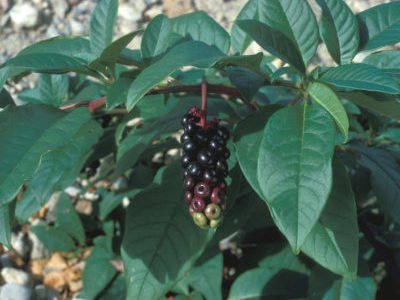

Phytolacca in cooking
The two main types of lentil berries secretly divided the fields of activity. American lakonos is used mainly in traditional medicine and scientific experiments, and berry - in folk therapy and in cooking.
Salads and stews made from young laconosus shoots are not the only way to make this plant tasty.
In Abkhazia, American medicinal herb is used as a spice: berries are put in jars when pickling cucumbers, cabbage and peppers with garlic. They give an unusual tart taste and pink tint to homemade pickles.
And if you grow Jewish ivy on your own plot, you can make an unusual salad out of it - almost like in 17th century America. Boiled lakonos tastes like ... ordinary asparagus.
Spring salad with young shoots of lakonos
You will need: 6-7 cups of laconosus shoots (collect only in spring!), 4 cloves of garlic, 2 tablespoons. tablespoons of olive oil, juice of half a lemon, 2 boiled eggs.
First you need to prepare the shoots. Wash them, chop them, then pour into a pot of boiling water and simmer for 1 minute. Drain, pour boiling water over again and boil again for a minute. Repeat all steps, but boil for 15 minutes the third time.
Then drain the water, dry the shoots on a towel and prepare the dressing. To do this, chop the garlic and fry for a couple of minutes in olive oil. Season the shoots with oil and lemon, add the chopped eggs and salt to taste.
Collecting, harvesting and storage of raw lakonos
Since berries and fruits are of great medicinal value, raw materials are harvested during the period of active growth and fruiting of the crop. The roots are harvested in the fall. At the same time, the raw materials are carefully dug out of the soil and thoroughly washed in running water. After that, the roots are laid out in an even layer in a dryer or oven and dried until the moisture completely disappears from the plant. The temperature during drying should not exceed 50 degrees. The fruits are dried in the same way.
Harvesting of leaves can take place during the active growth of the crop - the entire growing season. For this, the foliage is dried in dark, well-ventilated places. The resulting formulations can be mixed. Store dry lakonos in a dry, dark place. The maximum shelf life of dry raw materials is one year.
Precautions
Lakonos leaves are poisonous. Some believe they are safe to eat when young, and toxins develop over time as the plant grows older. But it is necessary to understand that the whole plant is poisonous: the seeds and root are also poisonous. The sap of the plant can cause dermatitis in sensitive people.
The plant contains substances that cause cell division, which leads to damage to chromosomes. These substances can be absorbed through any abrasions on the skin and lead to serious blood problems. Therefore, it is highly recommended that people wear gloves when picking berries and other plant parts.
Avoid using it during pregnancy (unless advised by your doctor). Children can be poisoned even by 1 berry, and for adults up to 10 berries are quite safe. In any case, raw consumption of any parts of the plant is not desirable.
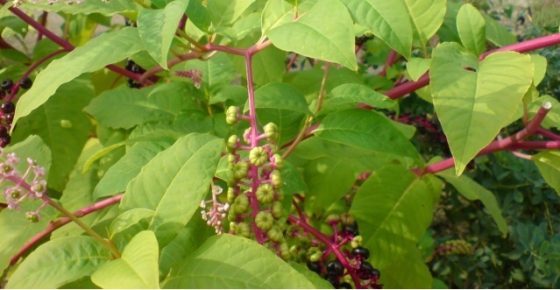

Fruit decoction
Berry juice helps to cope with swelling, removes wen. The benefits of its use are observed in diabetes and arterial hypertension. If a person wants to remove worms, improve metabolism, lose extra pounds, the broth from the fruit of the lakonos cannot be combined with wine, vodka, or low-alcohol cocktails. To make a healthy drink:
- The berries are seasoned with a glass of boiling water.
- Boil on fire for a couple of minutes.
- Pass through cheesecloth.
They use the remedy three times a day, but every other day fresh fruits are taken, and the medicine is prepared again.
In homeopathy, candles are made with laconos, which are effective in the treatment of prostatitis. The essence of the herb is added to drugs for malignant tumors, to drugs used in the treatment of fibroids, breast cancer, pathologies of the lymphatic system.
Lakonos is used not only in medicine. The berries are seasoned with marinades, resulting in hot and crunchy cucumbers and peppers. The juice of the fruit changes the color of the wool and silk fabric, gives an original shade to alcoholic beverages.
Blooming lakonos
Phytolacca inflorescences are presented in the form of small flowers with a burgundy hue. They have a sagittal shape and are collected in dense brushes. At the beginning of flowering, the inflorescences are white, and a little later they change their shade to burgundy.
The culture begins to bloom in mid-summer and ends in early autumn. After flowering, dark, glossy fruits appear on the lakonos, which are used by gardeners as seed material.
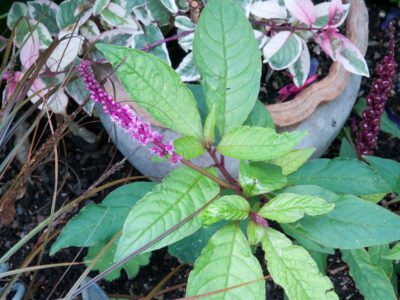

Perennial growing conditions
Phytolacca is very unpretentious in terms of growing conditions. By the way, because of this, very often a perennial is equated with a weed. Lakonos grows very well in our gardens, and does not need special preferences for good growth.


But for the splendor of the perennial and large, beautiful berry brushes, you need to satisfy some of the growing needs:
- Fertile soil is most suitable for the lakonos, while it should be loose, neutral. The best option is a cultivated, light loamy soil. Growing on poor land is a very bad idea, the lakonos will grow slowly, will not be able to reach normal size, the berries will be small and inconspicuous.
- Correct lighting plays a special role. The place should be with light partial shade, without direct sunlight, but also without strong shading. In regions with cold summers, it can be planted in sunnier areas, while in regions with dry and hot summers it is better to grow in partial shade (especially at noon).
- An exotic plant is moisture-loving, so the soil should be moisture-consuming, and the site itself should be moist. For this reason, you should not plant phytolacca and drought-resistant crops nearby.
- Phytolakke will grow most comfortably in areas that are well protected from strong winds and cold drafts. Otherwise, they may suffer from gusts of wind.
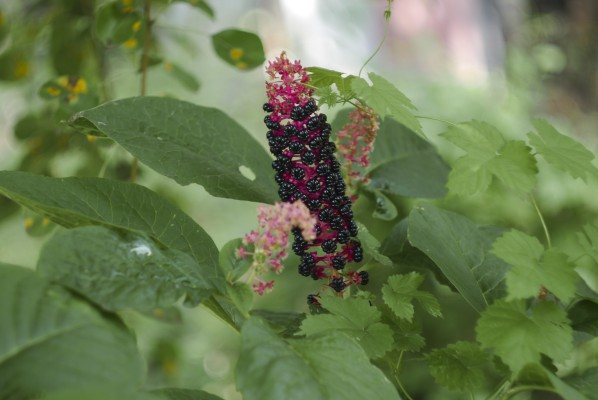

Planting and leaving
Basically, this plant is used by gardeners for the design of plots, as a representative of the exotic. Reproduction of Phytolakki is produced by a seed method, which is sown in autumn or spring. Seeds are sown in late October or April, directly to a permanent place. Before planting, seeds must be subjected to long-term hardening so that they can withstand winter frosts.
The landing site should be in a well-lit area, away from drafts and strong winds. Lakonos should grow away from other plants because it has the ability to destroy young shoots by breaking them. Before planting, the soil should be well dug up and fertilizer added. This culture is very fond of loose and fertile soil. On depleted soil, Phytolakka will lose its decorative qualities.
In the dug soil, we make grooves 2.5-3 cm deep and lay out the seeds at a distance of 40-50 cm between them. We fall asleep with soft earth and water abundantly. Lakonos rises very amicably and quickly. Since this plant is practically a weed, it does not require much maintenance. Due to its long taproots, Phytolakka easily reaches the moist layers in the soil.Therefore, this plant should only be watered during the dry season. Due to the presence of many chemicals, it is practically not exposed to diseases and pests. On the contrary, it scares away pests from other crops growing nearby.
Complications
If the lakonos is used incorrectly, a person may face the development of various complications. The poison contained in the components of medicinal raw materials can cause side effects such as:
- paralysis;
- symptoms of poisoning;
- violation of the stool;
- dizziness;
- nausea;
- cold feet and hands.
Therefore, it is possible to use lakonos, if there are concerns, only after consulting your doctor. In no case should the generally accepted dosage of the drug be exaggerated, as this can lead to the development of severe consequences.
Reviews of people about growing and eating
It is worth noting that reviews about the use of lakonos for medicinal purposes are mostly positive. For some people, drugs created on its basis helped to get rid of psoriasis caused by nerves, others - from severe back pain, and still others - to eliminate defects on the skin, which looked very unaesthetic. But everyone is equally fascinated by its beauty and unpretentious care, the possibility of using it as a background for any landscape decorations.
Of the shortcomings, people note the poisonousness of the lakonos. It is recommended not to plant in areas of houses whose owners are raising small children. It is also noted that when collecting leaves, roots and other parts of this plant and further processing them into raw materials for the preparation of medicines, it is imperative to wear personal protective equipment. Otherwise, you can burn yourself.
Lakonos transplant in summer
The transplant is carried out by carefully transferring the plant together with the soil into a new planting pit, at the bottom of which a drainage layer of fine expanded clay should be arranged. The soil should have neutral acidity and lightness.
After the transplant is made, the plant should be watered and the earth should be tamped a little. It is better to spend it in the summer.
It should be noted that the culture has a very spreading root system and therefore it can be easily damaged during transplantation, therefore experienced gardeners advise not to touch the plant, initially planting it in a place that will allow it to do without transplanting for a long time.


Natural dermatologist
Medicinal lakonos has found its wide application in the fight against various skin diseases, as it is able to disinfect and soothe it, to make it softer. For the creation of dermatological preparations based on it, mainly leaves and stems are used. The root is not used, as it can cause dryness and burning, and the berries, due to their ability to strongly stain the objects and things around them.
With lichen, erysipelas and eczema, an ointment prepared according to the following recipe shows good effectiveness: melt 1-2 tbsp. tablespoons of butter, mix well with the same amount of dried and crushed leaves, cool and put on a shelf in the refrigerator. Apply to a sore spot twice - in the morning and in the evening.
For boils, you can apply fresh lakonos leaves to the skin. It is recommended to do this every 2 hours, no longer than 20 minutes. With lipomas or wen, you can try to make such a remedy: chop fresh leaves into gruel and attach to the place on the skin where a benign tumor has appeared. It is recommended to repeat such actions until the wen is opened. Before treatment, you should definitely consult your doctor.
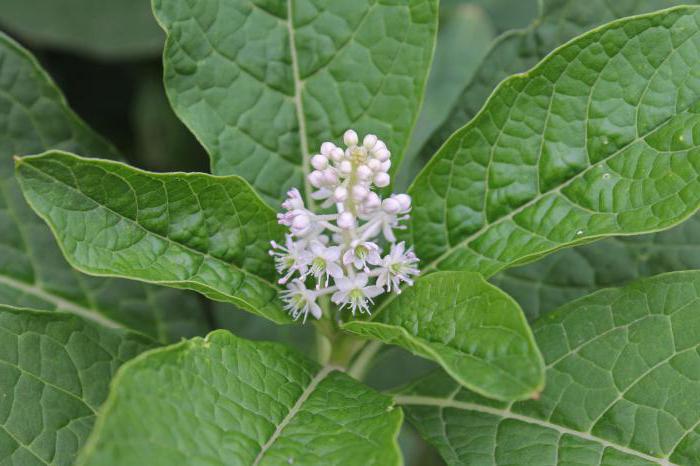

Preparing the lakonos for winter
Before the onset of frost, the aerial part of the plant should be completely cut off, removing the leaf plates and stems. Then the bed with the plant must be mulched.To do this, you need to take peat and scatter it in a thick layer over the area with laconic soil. A layer of dry foliage should be poured over the peat. Such a shelter will help the phytolacca survive the winter without damage.
In the spring, when the threat of frost has disappeared, the shelter must be removed to allow the plant to grow and develop without hindrance.
